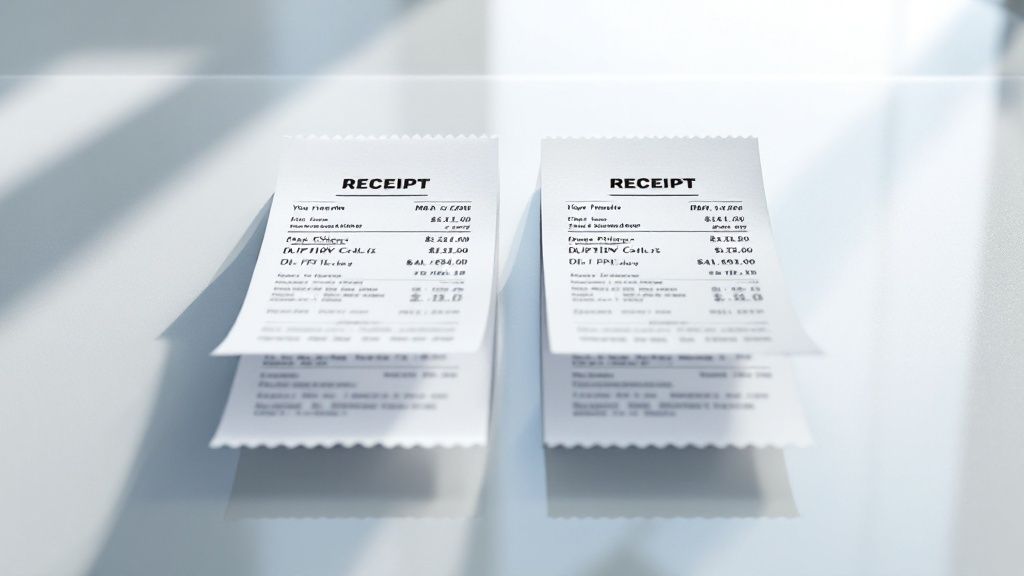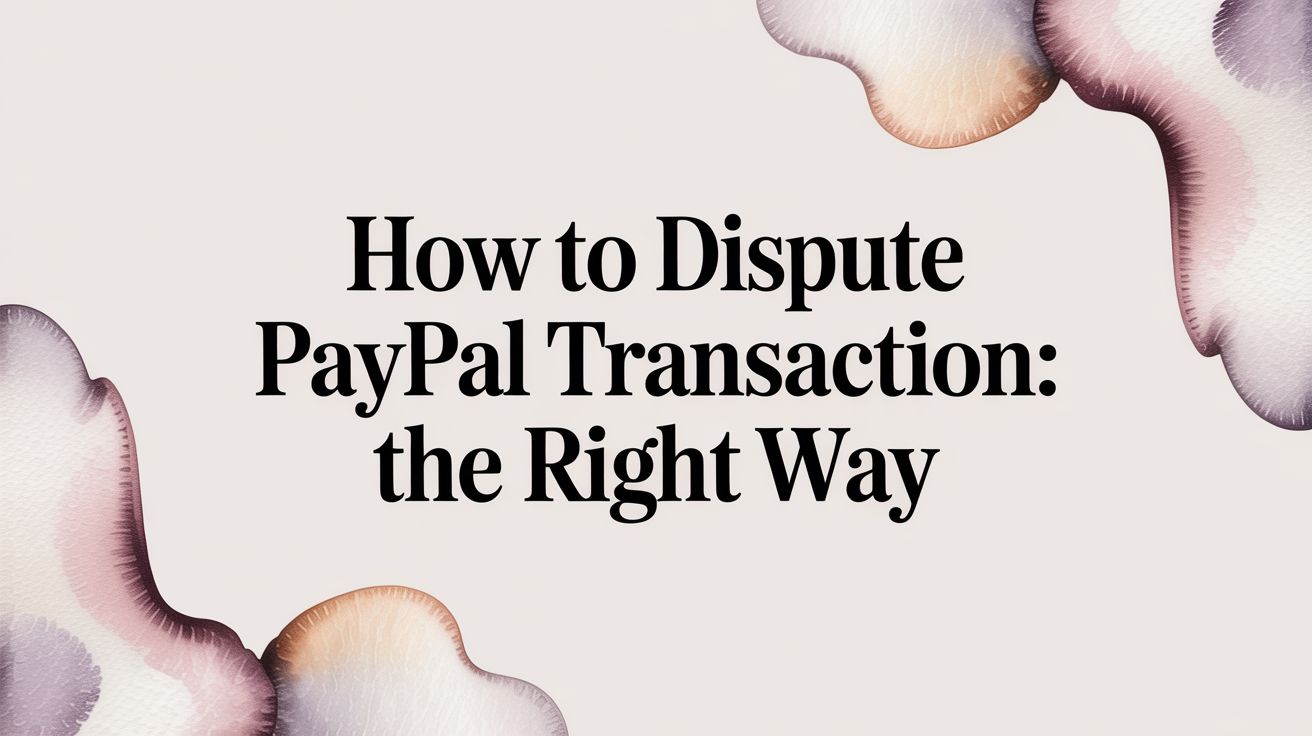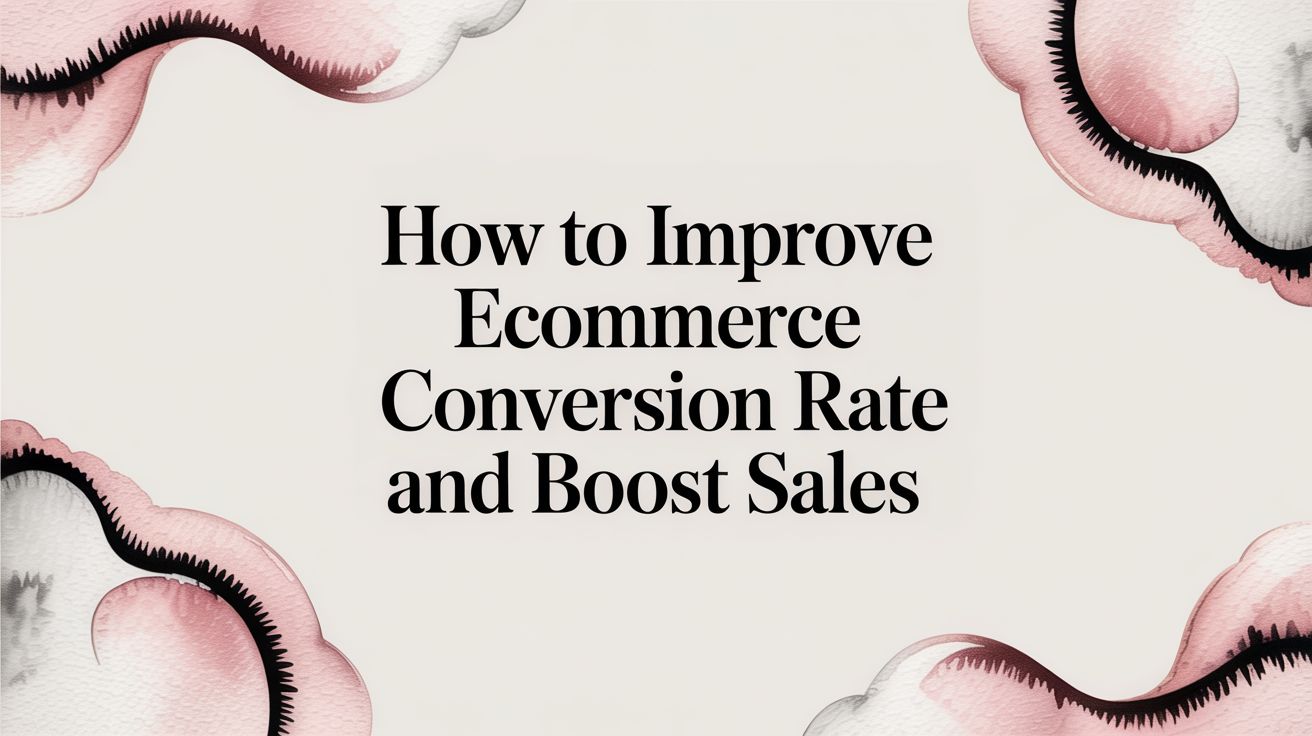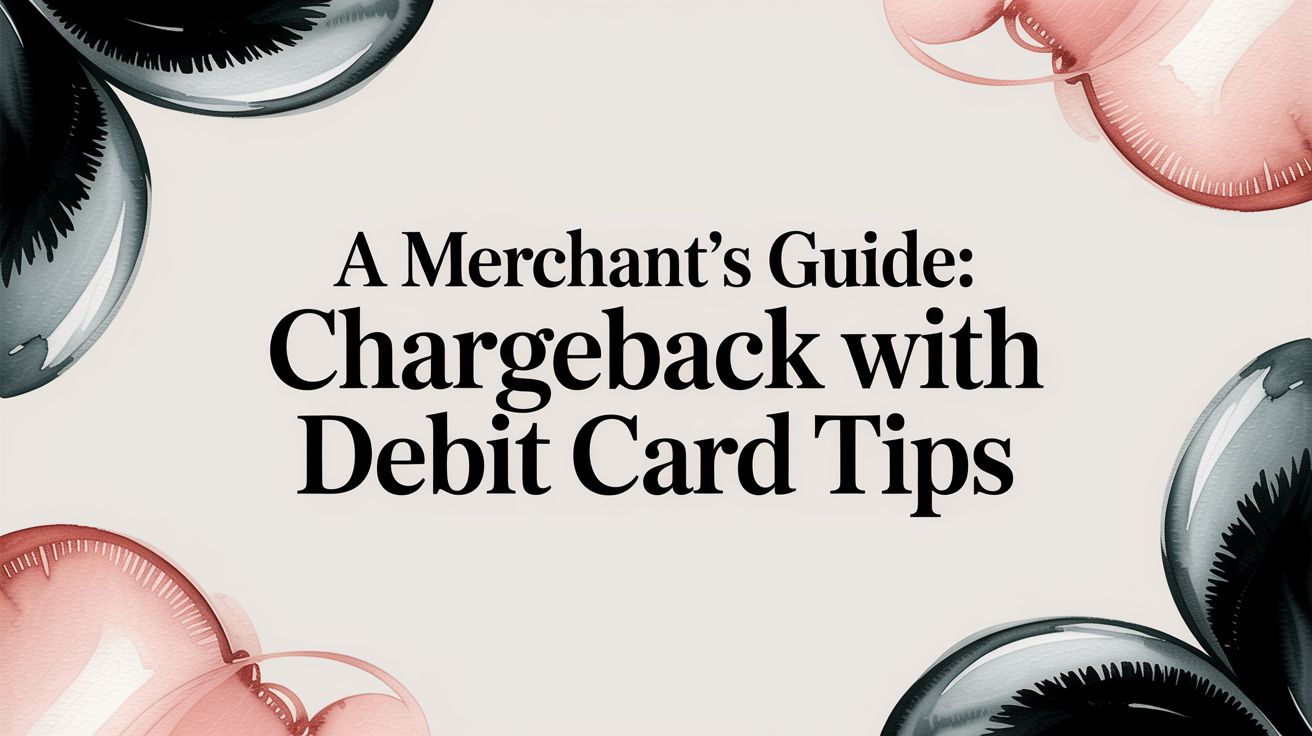
If you're a business owner, the word 'chargeback' can send a shiver down your spine. It feels like a sudden penalty, pulling revenue right back out of your account, often weeks after you’ve made a sale. But what's really happening behind the scenes? A chargeback isn't just a lost transaction; it's a direct signal from your customer or their bank that something in the buying process went wrong.
Understanding the specific reasons for a chargeback is the first and most important step to preventing them. Simply knowing they exist isn't enough. You need to know the 'why' behind each one to build a defense that actually works for your business.
This guide goes beyond generic advice to give you a clear, practical breakdown of the eight most common triggers. We'll explore everything from straightforward shipping mishaps and products that don't match their description to technical payment glitches and even the tricky issue of 'friendly fraud'. By the end, you'll have a solid roadmap not only for disputing chargebacks when they happen but, more importantly, for stopping them from happening in the first place. This protects your bottom line, saves you from hefty fees, and helps maintain a good relationship with your payment processor.
1. Non-Receipt of Goods/Services
One of the most common and understandable reasons for a chargeback is when a customer pays for an item or service but never receives it. This situation, known as non-receipt, is a direct breach of the sales agreement from the customer's perspective. They held up their end of the deal by paying, but you failed to deliver.

This issue can pop up at various points in the fulfillment process, such as shipping mix-ups, lost packages, or a simple failure to send the item out. For digital products, it could mean a customer never received their access credentials or download link after a successful payment.
Why This Chargeback Happens
The core issue is a complete failure of fulfillment. The customer is left with a charge on their card but nothing to show for it.
- Shipping Errors: The package is sent to the wrong address, stolen from the porch (if no delivery confirmation is obtained), or lost in transit by the carrier.
- Inventory Issues: An item is sold that is actually out of stock, and the merchant fails to communicate this or issue a timely refund.
- Service Non-Delivery: A consultant doesn't show up for a paid appointment, or a digital service provider fails to activate a customer's account.
Key Takeaway: For a customer, a non-receipt claim is straightforward. They have proof of payment but no product. The burden of proof shifts entirely to you to demonstrate successful delivery.
How to Prevent This Chargeback
Being proactive with fulfillment and keeping clear documentation are your best defenses. Your goal is to create an undeniable trail of evidence showing the item reached its destination.
- Always Use Tracking: Ship every physical product with a tracking number and, for higher-value items, require a signature upon delivery. This provides concrete proof that the package arrived at the correct address.
- Maintain Digital Records: For digital goods, keep detailed logs showing that access was granted, a download link was sent and clicked, or a user logged into their account successfully.
- Communicate Proactively: If you anticipate a shipping delay, inform the customer immediately. Managing expectations can prevent a customer from assuming their order is lost and initiating a chargeback.
For a deeper dive into handling these specific disputes on popular platforms, you can learn more about how to manage "item not received" claims on PayPal.
2. Fraudulent Transaction
A fraudulent transaction chargeback occurs when a cardholder’s account is used without their permission, making it one of the most clear-cut reasons for a chargeback. This is true, or "criminal," fraud where the legitimate cardholder is a victim of theft. They see a charge on their statement they didn't make or authorize and rightfully dispute it with their bank.

This situation isn't caused by a merchant's mistake or a customer service issue. It's the result of criminal activity, such as stolen card information being used for online purchases, an account takeover where a fraudster gains access to a customer's profile, or a widespread data breach that exposes payment details.
Why This Chargeback Happens
The root cause is a security failure, often completely outside your or the customer's direct control. The cardholder is not at fault, and the transaction was illegitimate from the start.
- Stolen Card Information: Physical card theft, card skimming devices, or malware can capture a customer’s payment details, which are then used to make unauthorized purchases.
- Data Breaches: A security breach at another company can expose thousands of customer credit card numbers, which are then sold and used by fraudsters.
- Phishing Scams: A customer may be tricked into providing their credentials through a fake email or website, leading to an account takeover.
Key Takeaway: In a true fraud case, the merchant almost always loses the dispute because the cardholder is a confirmed victim. Your focus should shift from winning the dispute to preventing the fraudulent transaction in the first place.
How to Prevent This Chargeback
Solid fraud detection and prevention tools are essential. Your goal is to identify and block suspicious transactions before they are even processed, protecting both your business and legitimate cardholders.
- Implement AVS and CVV Checks: Always require the Address Verification Service (AVS) and Card Verification Value (CVV) for every transaction. These are basic but effective checks to ensure the person making the purchase has the physical card.
- Use Advanced Fraud Filters: Set up velocity filters to flag multiple orders from the same IP address in a short time or multiple cards used with the same shipping address. Also, monitor for high-value orders that deviate from typical customer behavior.
- Maintain PCI DSS Compliance: Strictly adhere to Payment Card Industry Data Security Standard (PCI DSS) requirements to protect any stored payment data, making your systems a less attractive target for criminals.
Automated systems can significantly improve your detection capabilities. You can explore how to use AI technology to catch chargeback fraud and stop these disputes before they happen.
3. Product Not as Described
This type of chargeback occurs when a customer receives an item that is significantly different from what they were led to believe they were purchasing. The product might be damaged, a different color or size, a counterfeit, or missing key features that were advertised. This is a powerful reason for a chargeback because it centers on the merchant's failure to represent their product accurately.

From the customer's point of view, they did not get what they paid for. The issue could be a simple mistake, like shipping the wrong version of a product, or a more serious misrepresentation, such as an electronic device lacking advertised features. Essentially, the merchant did not fulfill the promise made on the product page.
Why This Chargeback Happens
The root cause is a mismatch between customer expectations, set by your advertising, and the reality of the product received.
- Inaccurate Descriptions: The product page contains outdated information, incorrect specifications, or exaggerated claims about the item's capabilities.
- Poor Quality Control: An item is shipped that is defective, damaged in the warehouse, or is a clear counterfeit of the advertised brand.
- Fulfillment Errors: The correct item was ordered, but the wrong size, color, or model was packed and shipped by mistake.
Key Takeaway: The burden of proof in "not as described" disputes falls on you to prove that the item sent perfectly matches the description and images the customer viewed at the time of purchase.
How to Prevent This Chargeback
Honesty and accuracy in your product listings are your strongest defenses. The goal is to ensure the customer receives exactly what they expect.
- Write Detailed and Honest Descriptions: Use clear, precise language. Include exact dimensions, materials, and features. Avoid vague marketing jargon and use high-resolution photos and videos that show the product from all angles.
- Implement Quality Checks: Before any item is shipped, have a process in place to verify it is the correct product, is free of defects, and matches the order specifications.
- Offer a Clear Return Policy: A hassle-free return and exchange process gives unsatisfied customers an easy alternative to a chargeback. Make your policy easy to find and understand.
To better understand the nuances of these disputes, you can learn more about how to handle unacceptable product chargebacks on ChargePay.ai.
4. Duplicate Processing
A duplicate processing chargeback happens when a customer is accidentally billed more than once for a single purchase. This is a clear-cut error that understandably frustrates customers, as they see multiple identical charges on their statement for something they only intended to buy once. Unlike fraud, this issue is almost always caused by a technical or human error on your end.

These errors can happen in a few ways. A customer might impatiently click the "submit payment" button multiple times, a glitch in the point-of-sale system might process the same card tap twice, or a recurring subscription system could malfunction and bill for the same period multiple times. From the customer’s view, it’s a straightforward overcharge that needs immediate correction.
Why This Chargeback Happens
The root cause is a failure in the transaction processing logic, leading to an unintentional repeat charge. This is one of the more preventable reasons for a chargeback because it stems from internal system or procedural flaws.
- Technical Glitches: A customer refreshes the checkout page after submitting payment, triggering the system to process the transaction again.
- System Errors: Your payment gateway or e-commerce platform experiences a momentary failure, causing it to send the same transaction batch twice.
- Human Error: An employee manually enters a credit card payment more than once or a subscription is mistakenly set up to run multiple times in a single billing cycle.
Key Takeaway: A duplicate processing chargeback is a direct signal of a technical or procedural breakdown. The customer has a valid claim, and it's your responsibility to identify and fix the source of the error.
How to Prevent This Chargeback
Solid payment systems and clear protocols are essential to avoid these entirely preventable disputes. The goal is to build safeguards that stop a duplicate charge before it ever happens.
- Use Unique Transaction IDs: Configure your payment system to assign a unique identifier to every single transaction. This allows your system to automatically reject any subsequent attempts with the same ID, preventing duplicates.
- Implement Duplicate Logic: Your payment gateway should have settings to detect and block transactions that appear to be duplicates, such as those with the same amount from the same card within a short time frame.
- Train Your Staff: Ensure anyone processing payments manually understands the correct procedure and knows how to avoid common mistakes, like re-running a card after a temporary "declined" message.
Carefully managing these issues is crucial, as mishandling a refund can sometimes lead to further complications. You can learn more about the complexities of double refund chargebacks to ensure you resolve these issues correctly the first time.
5. Cancelled Recurring Transaction
One of the most frustrating reasons for a chargeback for both customers and merchants is the "cancelled recurring transaction." This happens when a customer believes they have successfully cancelled a subscription or membership, yet they continue to see charges on their statements. From their perspective, the merchant is ignoring their request and taking money without authorization.
This dispute often comes from a disconnect between the customer's cancellation action and the merchant's billing system. It could be due to a confusing cancellation process, a missed communication, or simply a system error that fails to stop the automatic payments. Regardless of the cause, the customer feels they have no other choice but to file a chargeback to stop the billing.
Why This Chargeback Happens
The core issue here is a failure in the cancellation and billing process. The customer took action to end their financial relationship with the business, but the automated payments continued.
- Unclear Cancellation Procedures: The process to cancel is hidden, overly complicated, or requires a phone call during limited hours, leading the customer to believe an email or support ticket was sufficient.
- Timing Mismatches: A customer cancels just before the billing cycle renews, and the payment is already in a "pending" state, causing one final charge that the customer disputes.
- Lack of Confirmation: The customer sends a cancellation request but never receives confirmation, leaving them unsure if the subscription was actually terminated until the next charge appears.
Key Takeaway: When a customer cancels, they expect the charges to stop immediately. Any subsequent billing is seen as unauthorized, making this a common and legitimate reason for a chargeback.
How to Prevent This Chargeback
Making your cancellation process as clear and easy as your sign-up process is the best defense. Transparency and confirmation are key to avoiding these disputes.
- Provide an Easy Cancellation Path: Offer a simple, one-click "cancel" button within the customer's account dashboard. Forcing customers to call or email creates friction and increases the likelihood of a chargeback.
- Send Immediate Cancellation Confirmations: As soon as a customer cancels, send an automated email confirming the cancellation, the date it is effective, and what to expect regarding any final charges. This email serves as proof for both parties.
- Audit Your Billing System: Regularly check your recurring payment system to ensure that cancellation requests are being processed correctly and are successfully halting future payments. Fix any bugs that prevent subscriptions from being properly terminated.
6. Credit Not Processed
A "Credit Not Processed" chargeback occurs when a customer is promised a refund or credit, but the merchant fails to issue it in a timely manner. The customer has already taken the agreed-upon action, such as returning a product or canceling a service, and is now waiting for you to fulfill your promise of a credit. When that credit doesn't appear on their statement, the customer often resorts to a chargeback to reclaim their funds.
This type of dispute is particularly damaging because it comes from a failure in your internal processes after a customer interaction that was likely already a point of friction. You essentially agreed the customer was owed money but then failed to follow through, turning a resolved issue into a new, more serious problem.
Why This Chargeback Happens
The root cause is a breakdown in a merchant's refund and credit processing workflow. The promise was made, but the action was never completed, leading to one of the more frustrating reasons for a chargeback.
- Manual Processing Errors: An employee promises a refund but forgets to process it, or enters the details incorrectly.
- System Delays: The merchant's payment processing system has a significant delay between initiating a refund and the funds actually being returned, and this isn't communicated.
- Policy Confusion: The customer returns an item and expects a refund, but the merchant's policy is to issue store credit, leading to a dispute when the customer sees no money returned to their card.
Key Takeaway: This chargeback signals a failure in your post-sale customer service and financial operations. You acknowledged the customer was right, but then failed to make them whole.
How to Prevent This Chargeback
Efficiency and clear communication are crucial to preventing these disputes. Your refund process should be as reliable and transparent as your sales process.
- Process Refunds Promptly: Set a strict internal standard for processing all refunds and credits, ideally within 1-3 business days of the promise or returned item's receipt. Don't let requests sit idle.
- Send Refund Confirmations: Immediately after processing a refund, send an automated email confirmation to the customer. This message should state the amount refunded and provide an estimate of when they can expect to see it on their statement (e.g., "5-10 business days").
- Automate Where Possible: Use your e-commerce platform's tools (like Shopify's or PayPal's) to automate the refund process as much as possible. This reduces the risk of human error and creates a clear digital trail.
For a more comprehensive look at this specific issue, you can get more details on how to handle a Credit Not Processed chargeback.
7. Expired Authorization
This technical chargeback is one of the more subtle reasons for a chargeback, stemming from the merchant's internal processes rather than the customer's direct dissatisfaction. It happens when a merchant processes a transaction using an authorization code that has expired. When a customer makes a purchase, their bank approves the funds and provides an authorization that is valid for a limited time, and if you don't capture the payment within that window, the transaction can be disputed.
This issue is common in businesses with long fulfillment cycles, such as pre-orders or custom-made goods. You get the initial green light for the payment but wait too long to officially collect the funds, causing the original approval to become invalid.
Why This Chargeback Happens
The core issue is a timing mismatch between payment authorization and fund capture. You fail to finalize the sale within the timeframe set by the card networks and issuing banks.
- Delayed Shipping: A product is on backorder, and the merchant waits until the item ships weeks or months later to capture the payment, by which time the authorization has expired.
- Custom Orders: A custom furniture maker gets an authorization but only captures the payment after the piece is built, which can take longer than the authorization window.
- Pre-Orders: A video game company authorizes a card for a pre-order but doesn't capture the funds until the release date, which is months away.
Key Takeaway: An expired authorization chargeback is an unforced error. The customer was willing to pay, and their bank approved it, but a process delay on your end created the opening for the dispute.
How to Prevent This Chargeback
Careful payment processing and understanding authorization windows are critical. Your systems must align with the time-sensitive nature of card authorizations.
- Monitor Expiration Dates: Be aware of the authorization validity periods for the card networks you accept (typically 7-30 days). Track these dates for any uncaptured payments.
- Re-Authorize Transactions: If you know a fulfillment delay will exceed the authorization window, you must contact the customer to re-authorize the charge with their card issuer before capturing the funds.
- Adjust Business Processes: For businesses with long lead times, consider capturing a deposit upfront within the valid window or adjusting your billing cycle to capture funds immediately upon order rather than upon shipment.
8. Processing Error
Technical glitches and human error during the payment process are another one of the common reasons for a chargeback. Unlike fraud or service complaints, these disputes arise from a clear mistake in the transaction itself. The customer isn't necessarily unhappy with the product; they are contesting a demonstrable error in how their payment was handled.
These errors can include being charged the wrong amount, a duplicate transaction, or a mistake in currency conversion. From the customer’s point of view, their statement shows an incorrect charge that does not match their purchase agreement, making a chargeback a logical step to correct the financial discrepancy.
Why This Chargeback Happens
The root cause is a breakdown in the payment processing chain, which can be either technical or manual. The customer recognizes the transaction but disputes the details.
- Duplicate Charges: A customer is billed twice for a single purchase, often due to a system timeout, a network error, or accidentally clicking the "submit" button more than once.
- Incorrect Amount: A simple decimal point error can turn a $15.50 charge into $1550, or an incorrect tax calculation can overcharge the customer.
- Currency Conversion Errors: An international customer might be charged in the wrong currency or at an incorrect conversion rate, leading to a significantly higher final bill than expected.
Key Takeaway: Processing error chargebacks are typically not malicious. They represent a failure in the transaction mechanics. The customer has clear evidence of the error on their bank statement, making it difficult for merchants to dispute without their own flawless records.
How to Prevent This Chargeback
Vigilance, robust systems, and well-trained staff are crucial to minimizing these technical mishaps. Your aim is to catch errors before they ever reach the customer's bank.
- Implement Transaction Validation: Use payment gateway settings that prevent duplicate submissions within a short time frame from the same customer or for the same order ID.
- Conduct Regular System Audits: Routinely test your payment processing software and POS terminals to ensure they are calculating totals, taxes, and currencies correctly.
- Train Staff on Procedures: Ensure any employee handling manual transactions is thoroughly trained on the payment system to prevent simple data entry errors, like an extra zero. If an error is spotted, empower them to void it and re-run the transaction correctly.
Top 8 Chargeback Reasons Comparison
Turn Chargeback Headaches into a Smarter Business Strategy
Dealing with chargebacks can feel like you're constantly on the defensive. But after breaking down the most common reasons for a chargeback, a clearer picture emerges. The truth is, most of these disputes aren't just random attacks on your revenue; they are direct signals pointing to areas of your business that need a tune-up.
From a customer claiming they never received their order to a dispute over a cancelled subscription, nearly every chargeback is a learning opportunity. Think of them less as a penalty and more as a powerful form of customer feedback. A spike in "product not as described" disputes, for example, is a clear sign to revisit your product pages, add more detailed photos, or clarify your item descriptions. Similarly, issues with duplicate processing or uncredited returns highlight gaps in your operational workflow.
From Reactive to Proactive: A Shift in Mindset
The key to reducing chargebacks is shifting from a reactive stance to a proactive one. Instead of just waiting for disputes to happen and fighting them, you can build a system that prevents them from occurring in the first place. This involves a three-pronged approach:
- Operational Excellence: Double-check your fulfillment processes to ensure timely shipping and delivery. Refine your billing system to prevent duplicate charges and processing errors.
- Crystal-Clear Communication: Make your return policies, shipping times, and product details impossible to misunderstand. An informed customer is far less likely to file a dispute.
- Exceptional Customer Service: Many chargebacks are filed simply because a customer couldn't easily get in touch with you to resolve an issue. Making your support team accessible and responsive is one of the most effective prevention strategies. Ultimately, a proactive approach to customer satisfaction can significantly reduce the likelihood of chargebacks. For a deeper dive, consider these strategies to improve customer satisfaction and boost loyalty and turn one-time buyers into repeat customers.
Embrace Automation for a Stronger Defense
Even with the best prevention strategies in place, some chargebacks are inevitable, especially those stemming from true fraud. Manually fighting each one is a significant drain on your time and resources, pulling you away from growing your business.
This is where automation becomes your most valuable ally. Modern tools can handle the entire dispute process for you, from gathering the right evidence to submitting compelling, AI-generated responses tailored to each specific reason code. By automating your chargeback management, you not only recover more revenue but also gain invaluable time back. You can transform a process that once felt like a headache into a streamlined, efficient system that protects your bottom line and strengthens your business operations from the inside out.
Ready to stop losing revenue to preventable disputes? ChargePay uses AI to automate the entire chargeback process for Shopify and PayPal merchants, recovering lost sales on your behalf. See how ChargePay can turn your chargeback problem into a profit center.







.svg)







.svg)
.svg)
.svg)